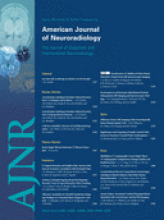Abstract
BACKGROUND AND PURPOSE: Conventional CT angiography (CTA) is acquired during only a short interval in the arterial phase, which limits its ability to evaluate the cerebral circulation. Our aim was to compare the image quality and radiation dose of conventional single-phase CTA (SP-CTA) with a multiphase CTA (MP-CTA) algorithm reconstructed from a perfusion CT (PCT) dataset.
MATERIALS AND METHODS: Fifty consecutive patients undergoing head CTA and PCT in 1 examination were enrolled. The PCT dataset was obtained with 40.0-mm-detector coverage, 5.0-mm axial thickness, 80 kilovolt peak (kVp), 180 mA, and 30 mL of contrast medium. MP-CTA was reconstructed from the same PCT dataset with an axial thickness of 0.625 mm by using a new axial reconstruction algorithm. A conventional SP-CTA dataset was obtained with 0.625-mm axial thickness, 120 kVp, 350 mA, and 60 mL of contrast medium. We compared image quality, vascular enhancement, and radiation dose.
RESULTS: SP-CTA and MP-CTA of 50 patients (male/female ratio, 31/19; mean age, 59.25 years) were analyzed. MP-CTA was significantly better than SP-CTA in vascular enhancement (P = .002), in the absence of venous contamination (P = .006), and was significantly higher in image noise (P < .001). MP-CTA used less contrast medium than SP-CTA and could demonstrate hemodynamic information. The effective dose of MP-CTA was 5.73 mSv, which was equal to that in conventional PCT, and it was 3.57 mSv in SP-CTA.
CONCLUSION: It is feasible that MP-CTA may provide both CTA and PCT results. Compared with SP-CTA, MP-CTA provides comparable image quality, better vascular enhancement, hemodynamic information, and more noise with less detail visibility with a lower tube voltage. The radiation dose of MP-CTA is higher than that of SP-CTA, but the dose can be reduced by altering the sampling interval.
- Copyright © American Society of Neuroradiology












